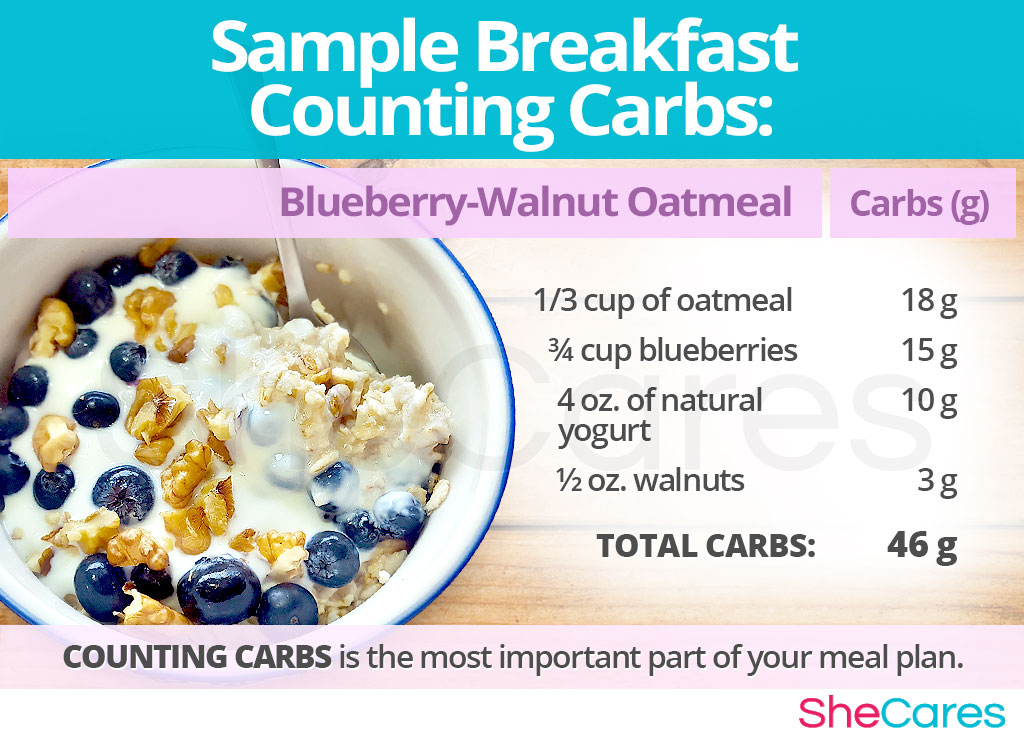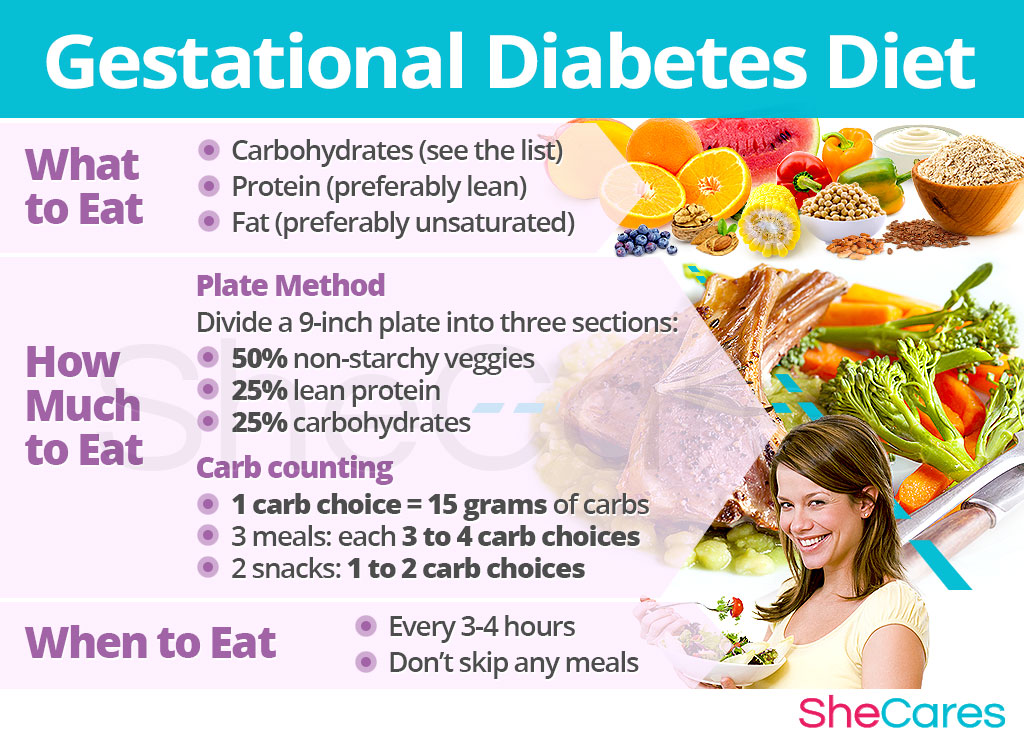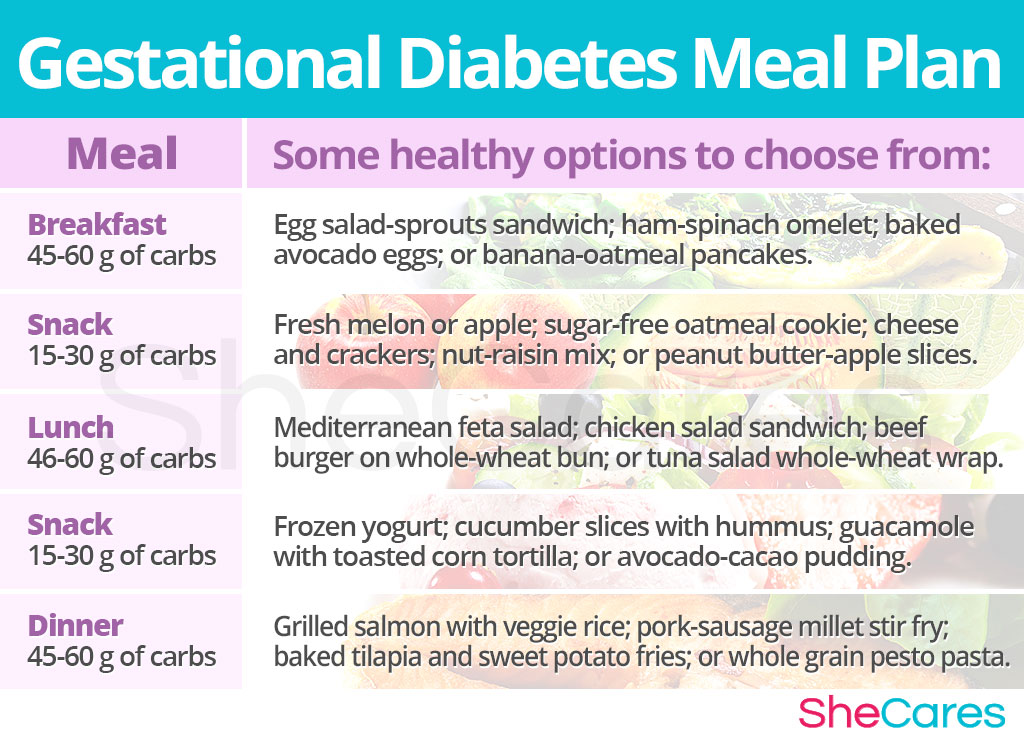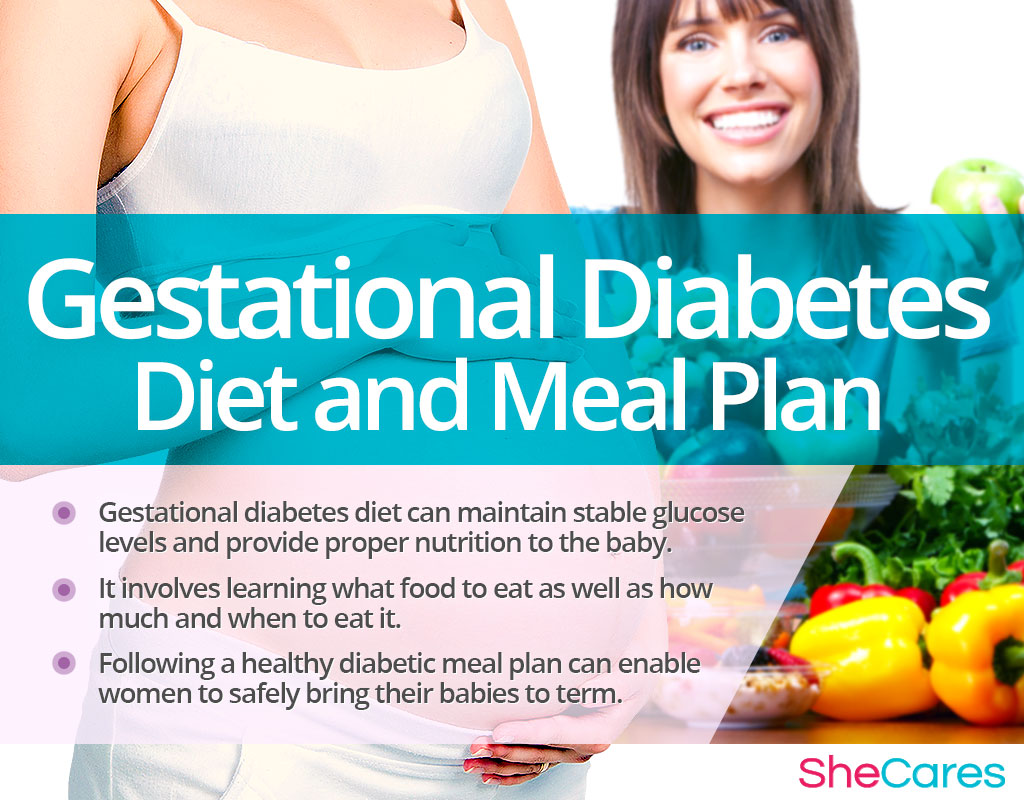Gestational Diabetes Diet
Following a gestational diabetes diet plan is all about making better food choices. When you know what effects various food groups have on your sugar levels, making nutritional choices to sustain a pregnancy diabetes diet is much easier. It requires three steps:
- Learning what to eat: Carbohydrates, proteins, and fats
- Learning how much to eat: Plate method and Carb counting
- Learning when to eat: Meal spacing
These basic concepts of healthy eating will keep your blood glucose levels stable throughout pregnancy and provide sufficient nutrition to you and your baby. Let's break it down:
What to Eat
Your first step is to learn what foods can elevate your blood sugar levels. Your diet should be composed of three macronutrients: carbohydrates, proteins, and fats.
Carbohydrates
By eating carbohydrates, we give our body the energy and nutrients it needs. Carbohydrates, particularly their two types, sugars and starches, elevate blood glucose levels, while the third type, fiber, does not cause glucose spikes and is essential for proper digestion. It is important to include all three in your diet, but opt for those carbohydrates that are high in vitamins and minerals.
Good for you:
- Raw fruits, like blueberries, oranges, watermelon, or mango
- Starchy vegetables, like peas, corn, sweet potatoes, or beets
- Non-starchy vegetables (low in carbs and high in fiber), like lettuce, broccoli, or peppers
- Dried beans, like chickpeas, kidney beans, or lentils
- Whole grains, like brown rice, buckwheat, or oatmeal, whole-wheat pasta
- Nuts, like walnuts, almonds, or Brazil nuts
- Seeds, like quinoa, chia, or flax
- Dairy, like milk, natural yogurt, or cottage cheese
Avoid:
- table sugar, syrups, molasses,
- candy, cakes, cookies, donuts, ice-cream, soft drinks,
- fruit juices, fruit jams, canned fruits with heavy syrup
- refined starches and fiber: white flour, white rice, white bread, white potatoes, non-whole wheat pasta
Protein
They are the building blocks of muscles, skin, and bones and are also abundant in important nutrients. Proteins don't elevate blood glucose levels, but their excess might keep them high for longer.
Good for you:
- Lean animal protein, like eggs, chicken, turkey, or salmon
- Plant protein, like dried beans, peas, nuts
Avoid:
- Read meat, such beef and pork
- Processed meat products, such as ham and bacon
- Raw fish or fish that contains high mercury levels, such as swordfish or mackerel
Fat
We need fat for energy, cell growth, and proper temperature control. Fat does not increase glucose either, but similarly to protein, if you eat a lot of fat, your glucose levels might take more time to return to normal.
Good for you:
- Unsaturated fats, like olive oil, safflower oil; avocado; nuts and seeds
Avoid:
- Saturated and trans fats, such as butter, palm oil, lard, pork, fatty beef
It is important to take into consideration that some foods might provide you with two or three macronutrients. For example, beans or dairy have both proteins and carbohydrates.
How Much to Eat
Your second step is to learn portion control. It helps you stay within a healthy sugar range and get enough nutrients to support your pregnancy. Two techniques come in handy:
Plate Methods
Take a 9-inch plate, visualize making three sections, and fill it with foods in the following way:1
- 50% non-starchy veggies
- 25% lean protein
- 25% carbohydrates
+ a small side bowl of fresh fruits or yogurt
Carb Counting
As you fill your plate with proper foods, you also have to remember your carbs allowance. Carb counting involves keeping track of your daily intake of foods containing carbohydrates. The rules are as follows:2
- 1 carb choice (or a serving) equals to 15 grams of carbohydrates
- Each meal should consist of 3 to 4 carb choices (total of 45-60 grams of carbs/meal)
- Each snack should consist of 1 to 2 carb choices (total of 15-30 grams of carbs/snack)
At first, it might sound confusing, but with practice, you will learn how many carbohydrates a given food contains and how to combine them to make a wholesome and balanced gestational diabetes meal. For example, ½ banana or 6oz. of yogurt both count as 1 carb choice.

Food Labels
It is more difficult to control your carb intake when eating store-bought food products, so reading labels is a useful habit to develop. Learn how to analyze food labels.
When to Eat
At last, your third step is to learn how to space your meals properly throughout the day. Remember the following recommendations:
- Eat 3 well-balanced meals a day each containing carbohydrates, proteins, and healthy fats. You might have up to 2 healthy snacks per day.
- Try to eat every 3 to 4 hours remembering portion control.
- Don't skip any meals. This will aid with proper carbs absorption and maintain stable glucose levels.

Creating a Meal Plan for Gestational Diabetes
When you compose your meals, opt for better choices of carbohydrates, protein, and fats, so you not only keep diabetes at bay, but also ensure that your baby is getting all the nutrients it needs. For example, a small muffin has the same amount of carbs as a cup of fresh fruit, but it does not contain the same amount of nutrients.
The following tips might help you optimize your meal plan:
- Try baking, broiling, or grilling your food instead of frying.
- Keep healthy snacks handy, such as nuts or hummus with celery sticks.
- Give natural sweeteners, such a stevia or yacon, a try.
- Create a list of the foods you like and research their carb content in terms of a “1 carb choice.”
- Drink plenty of water or fruit water throughout the day.
Here is an example of a well-balanced gestational diabetes menu, which includes 3-4 choices (servings) of carbohydrates and 1 serving of fat and protein each:
More breakfast ideas: Poached egg-avocado toast, mushroom-spinach omelet, or banana-mango oatmeal pancakes.
More snack ideas: Guacamole with carrot sticks; sugar-free gelatin, or avocado-cocoa pudding.
More lunch ideas: Cucumber-feta salad, black been burger on whole-wheat bun, or brown rice veggie sushi.
More snack ideas: Hummus-cucumber bites, tropical fruit salad, or peanut butter-banana slices.
Other dinner options: Grilled chicken with mushroom risotto, Italian sausage and peppers brown rice, or zucchini noodles with shrimp.

It's always recommended to consult with your obstetrician or antenatal dietician over any meal plan that you'll consider. Also, remember to monitor your glucose levels frequently and make adjustments to your diet, if needed.
For more nutritional information on meal plans, take advantage of the following resources:
- United States Department of Agriculture - Food Composition Database, https://ndb.nal.usda.gov/ndb/
- American Diabetes Association - My Food Advisor, http://www.diabetes.org/mfa-recipes/meal-plans/
Key Takeaways
Remember that switching to a gestational diabetes diet takes time and patience. Once you get a hang of it, you might consider keeping some of those healthy eating habits past your pregnancy, such as composing your meals with foods from various groups, remembering portion control, or evenly spacing your meals during the day. These diet rules will maintain steady glucose levels and ensure that you and your baby remain healthy and optimally nourished throughout your pregnancy.
Sources
- American Diabetes Association. (2015). Meal Planning Made Simple. Retrieved November 24, 2017 from http://www.diabetesforecast.org/2010/apr/meal-planning-made-simple.html
- American Diabetes Association. (2017). Protein Foods. Retrieved November 27, 2017 from http://www.diabetes.org/food-and-fitness/food/what-can-i-eat/making-healthy-food-choices/meat-and-plant-based-protein.html
- American Diabetes Association. (2017). Eating Patterns and Meal Planning. Retrieved November 27, 2017 from http://www.diabetes.org/food-and-fitness/food/planning-meals/diabetes-meal-plans-and-a-healthy-diet.html
- Diabetes Forecast. (2010). Meal Planning Made Simple. Retrieved November 27, 2017 from http://www.diabetesforecast.org/2010/apr/meal-planning-made-simple.html
- Diabetes UK. (n.d.). Understanding food labels. Retrieved November 27, 2017 from https://www.diabetes.org.uk/guide-to-diabetes/enjoy-food/food-shopping-for-diabetes/understanding-food-labels
- Mayo Clinic. (2017). Diabetes diet: Create your healthy-eating plan. Retrieved November 27, 2017 from https://www.mayoclinic.org/diseases-conditions/diabetes/in-depth/diabetes-diet/art-20044295
- Mayo Clinic. (2016). Reading food labels: Tips if you have diabetes. Retrieved November 27, 2017 from https://www.mayoclinic.org/diseases-conditions/diabetes/in-depth/food-labels/art-20047648
- National Institute of Diabetes and Digestive and Kidney Diseases. (2014). Carbohydrate Counting and Diabetes. Retrieved November 27, 2017 from https://www.niddk.nih.gov/health-information/diabetes/overview/diet-eating-physical-activity/carbohydrate-counting
- University of California. (n.d.). Learning to Read Labels. Retrieved November 27, 2017 from https://dtc.ucsf.edu/living-with-diabetes/diet-and-nutrition/understanding-carbohydrates/counting-carbohydrates/learning-to-read-labels/
Footnotes:
- CDC. (2021). Diabetes Meal Planning. Retrieved September 8, 2021 from https://www.cdc.gov/diabetes/managing/eat-well/meal-plan-method.html
- CDC. (2021). Carb counting. Retrieved September 8, 2021 from https://www.cdc.gov/diabetes/managing/eat-well/diabetes-and-carbohydrates.html
